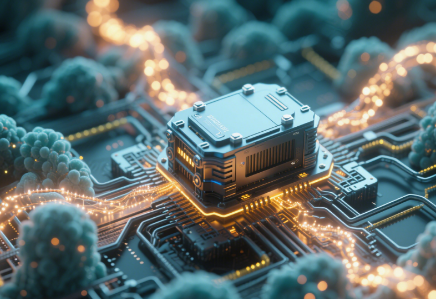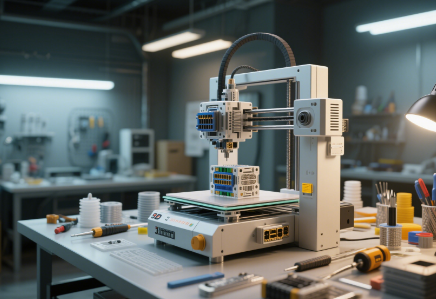Exploring the Depths: The Breakthrough Paths of High - Density Energy Storage at the Micro Level
1/15/2025 5:52:09 PM
In the miniaturization and IoT era, high - density micro - level energy storage is in high demand. Wearables, implantable medical devices, and IoT sensors need compact yet powerful energy storage. This article explores the latest R&D on high - density micro - energy storage, covering technologies, applications, and challenges.
The Significance of High - Density Energy Storage at the Micro Level
Powering the Miniaturized World
IoT devices need energy for data handling. Micro - scale IoT sensors, used in smart cities and industries, can be self - sufficient with high - density energy storage. They can harvest ambient energy (solar, thermal, etc.) and store it, reducing battery use and making IoT more sustainable. For instance, smart city environmental sensors can run on high - density energy storage, monitoring conditions without external power.
Research focuses on new battery materials and architectures. Scientists explore high - energy - density materials like lithium - sulfur and solid - state batteries. Lithium - sulfur batteries offer higher density than lithium - ion, suitable for space - constrained devices. Solid - state batteries use solid electrolytes, improving safety and lifespan.
Innovative architectures, such as 3D designs with nanowires or porous structures, enhance performance. They increase electrode surface area for better ion diffusion and charge storage, and improve battery flexibility for wearable use.
Supercapacitors and Hybrid Energy Storage Systems
Supercapacitors, which store energy electrostatically, charge and discharge quickly, ideal for high - power needs. But they have lower energy density than batteries. To address this, hybrid systems combine battery and supercapacitor benefits. These can store large amounts of energy and deliver high power, like in a wearable tracker where the battery provides long - term power and the supercapacitor powers short - term high - power tasks.
Energy Harvesting and Conversion Technologies
Energy harvesting technologies convert ambient energy (solar, thermal, etc.) into electricity. Solar cells are common in wearables and IoT sensors, and thermoelectric generators can use temperature differences. Integrating these with high - density energy storage makes micro - scale devices self - powered. For example, a remote wireless sensor can use solar cells and a high - density battery to operate day and night.
Real - World Applications of High - Density Energy Storage at the Micro Level
Healthcare and Medical Devices
High - density energy storage powers implantable devices like pacemakers, ensuring patient safety. Wearable medical devices also rely on it. Energy harvesting, combined with high - density storage, keeps these devices running without frequent recharging.
Consumer Electronics and Wearables
In consumer electronics, high - density energy storage is crucial for long - lasting, compact devices. Smartphones, tablets, and wearables need advanced batteries. Energy harvesting, such as solar cells in wearables, supplements battery power for longer operation.
Internet of Things (IoT) and Sensor Networks
IoT devices need energy for communication. High - density energy storage, often with energy harvesting, powers remote IoT sensors. For example, forest environmental sensors can use solar - charged high - density batteries to monitor continuously.
Challenges and Future Outlook
Technical Challenges
Despite progress, challenges remain. Developing materials for high energy density, long cycle life, and fast charging simultaneously is difficult. Integrating energy storage with other components in micro - scale devices without sacrificing performance is also a hurdle. Safety and reliability of energy storage devices, like lithium - ion battery risks, are important areas of research.
Cost and Commercialization Challenges
High - density energy storage technologies are costly, limiting adoption. Developing advanced battery materials requires significant investment. To reduce costs, researchers and industry are working on efficient manufacturing and production scaling, with government support.
Future Outlook
The future of high - density micro - energy storage is promising. New materials and technologies are emerging, and energy harvesting will play a bigger role. Integration with AI, blockchain, and 5G will create new applications. In summary, this field will transform device powering, though challenges remain. Continued R&D will likely lead to breakthroughs as we move towards a sustainable, connected future.
The Significance of High - Density Energy Storage at the Micro Level
Powering the Miniaturized World
Micro - scale devices are common in modern tech. Despite their small size, they perform complex, energy - intensive tasks. High - density energy storage is key for long - lasting operation without frequent recharging. For example, a smartwatch needs a compact, reliable power source, like a high - density battery, to function.
Enabling Sustainable IoT EcosystemsIoT devices need energy for data handling. Micro - scale IoT sensors, used in smart cities and industries, can be self - sufficient with high - density energy storage. They can harvest ambient energy (solar, thermal, etc.) and store it, reducing battery use and making IoT more sustainable. For instance, smart city environmental sensors can run on high - density energy storage, monitoring conditions without external power.
Technological Breakthroughs in High - Density Energy Storage

Research focuses on new battery materials and architectures. Scientists explore high - energy - density materials like lithium - sulfur and solid - state batteries. Lithium - sulfur batteries offer higher density than lithium - ion, suitable for space - constrained devices. Solid - state batteries use solid electrolytes, improving safety and lifespan.
Innovative architectures, such as 3D designs with nanowires or porous structures, enhance performance. They increase electrode surface area for better ion diffusion and charge storage, and improve battery flexibility for wearable use.
Supercapacitors and Hybrid Energy Storage Systems
Supercapacitors, which store energy electrostatically, charge and discharge quickly, ideal for high - power needs. But they have lower energy density than batteries. To address this, hybrid systems combine battery and supercapacitor benefits. These can store large amounts of energy and deliver high power, like in a wearable tracker where the battery provides long - term power and the supercapacitor powers short - term high - power tasks.
Energy Harvesting and Conversion Technologies
Energy harvesting technologies convert ambient energy (solar, thermal, etc.) into electricity. Solar cells are common in wearables and IoT sensors, and thermoelectric generators can use temperature differences. Integrating these with high - density energy storage makes micro - scale devices self - powered. For example, a remote wireless sensor can use solar cells and a high - density battery to operate day and night.
Real - World Applications of High - Density Energy Storage at the Micro Level
Healthcare and Medical Devices
High - density energy storage powers implantable devices like pacemakers, ensuring patient safety. Wearable medical devices also rely on it. Energy harvesting, combined with high - density storage, keeps these devices running without frequent recharging.
Consumer Electronics and Wearables
In consumer electronics, high - density energy storage is crucial for long - lasting, compact devices. Smartphones, tablets, and wearables need advanced batteries. Energy harvesting, such as solar cells in wearables, supplements battery power for longer operation.
Internet of Things (IoT) and Sensor Networks
IoT devices need energy for communication. High - density energy storage, often with energy harvesting, powers remote IoT sensors. For example, forest environmental sensors can use solar - charged high - density batteries to monitor continuously.
Challenges and Future Outlook
Technical Challenges
Despite progress, challenges remain. Developing materials for high energy density, long cycle life, and fast charging simultaneously is difficult. Integrating energy storage with other components in micro - scale devices without sacrificing performance is also a hurdle. Safety and reliability of energy storage devices, like lithium - ion battery risks, are important areas of research.
Cost and Commercialization Challenges
High - density energy storage technologies are costly, limiting adoption. Developing advanced battery materials requires significant investment. To reduce costs, researchers and industry are working on efficient manufacturing and production scaling, with government support.
Future Outlook
The future of high - density micro - energy storage is promising. New materials and technologies are emerging, and energy harvesting will play a bigger role. Integration with AI, blockchain, and 5G will create new applications. In summary, this field will transform device powering, though challenges remain. Continued R&D will likely lead to breakthroughs as we move towards a sustainable, connected future.




